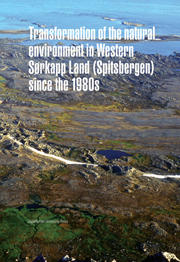Landscape development
from Conclusions and prognosis for environmental change
Published online by Cambridge University Press: 05 September 2014
Summary
A clear climate change, reflected in a significant increase in air temperature and atmospheric precipitation, is the reason for an increase rate of landscape development. There- fore, each environmental-landscape component, apart from solid bedrock, has changed.
The first and direct result of climate warming has been glacial recession, which stimulated an entire process of landscape (and seascape) changes along the eastern boundary between western Sørkapp Land (devoid of glaciers during the Holocene) and the glaciated peninsula's interior. These profound landscape changes, described above, have mainly been the result of the after-effects of the glaciers' retreat. A completely new landscape has appeared.
The fore-fields of glaciers, i.e. areas outside the glaciers' maximum extent, have been indirectly influenced by the glaciers' retreat. Landforms, Quaternary deposits and water networks have been significantly affected, especially on the coastal plains in the north and south of the study area: Gåshamnøyra and Tørrflya.
Some sequences of non-glacial and non-postglacial coastline have been affected by an increase in the geomorphic activity of the sea due to a shorter sea-ice season, which can be observed via a clear retreat (under abrasion) or advance (under accumulation) of the coastline. The formation of new coastlines at the front of the tidewater glaciers (Körberbreen and Olsokbreen) is a more complicated process.
- Type
- Chapter
- Information
- Transformation of the Natural Environment in Western Sorkapp Land (Spitsbergen) since the 1980s , pp. 85 - 86Publisher: Jagiellonian University PressPrint publication year: 2011



